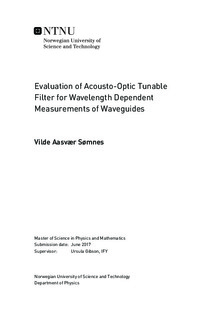| dc.description.abstract | The main part of the work done for this master's thesis have been to implement and characterize a setup that would allow for wavelength dependent measurements of losses in waveguides. A plasma enhanced white light source have been used with an Acousto-Optic Tunable Filter (AOTF) to filter out a narrow bandwidth of wavelengths for wavelength dependent measurements.
The AOTF is designed to operate with a white light laser and the first part of the work was to determine the required characteristics of the input beam and to make the plasma enhanced white light source work with the AOTF. It was found that the light going into the Acoust-optic tunable filter had to be collimated, polarized and sent straight into the filter. Consequently, a setup was designed and implemented to satisfy these requirements.
Thin film waveguides were spin-coated to test the different source and detection schemes. This has not been a study of the losses in waveguides, but a presentation of what setup will allow for wavelength dependent measurements of losses in waveguides and what limitations the various setups have. The losses were found for different wavelengths in the range from 600nm to 1100nm to show the application of the setups that were designed, when using a Silicon or a Germanium detector in one setup configuration, and when using a spectrometer in a different setup.
Different detection schemes, including a microscope camera, a USB spectrometer, and a Germanium or Silicon detector with a lock-in detector and a scanning fiber probe were used. Measuring the losses with the spectrometer enabled measurements of all wavelengths at the same time, but the signal-to-noise ratio was fairly low and the scanning and data acquisition process was manual, and therefore time consuming and with a low resolution. The detection of the scattered light using a lock-in amplifier with a detector gave a higher signal-to-noise ratio which allowed for longer scans. | |

